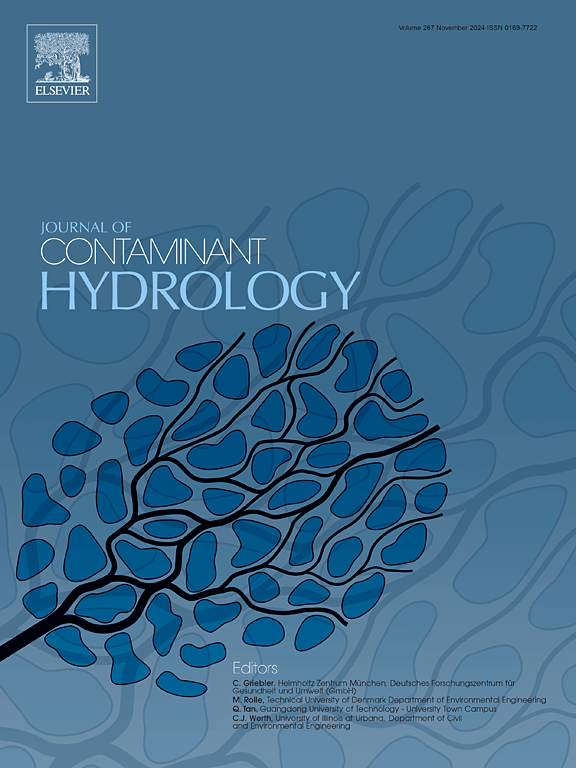光谱诱导极化技术在活性炭作为渗透反应屏障材料除锌监测中的应用
IF 3.5
3区 环境科学与生态学
Q2 ENVIRONMENTAL SCIENCES
引用次数: 0
摘要
由于采矿作业和废弃电池,锌在地下水中积累,对环境安全和人类健康构成威胁。活性炭(AC)是一种经济实惠的可渗透反应屏障(PRB)原位锌修复介质。本研究采用光谱诱导极化技术监测的柱突试验,结合显微分析研究了活性炭PRB中锌的保留行为。化学分析表明,Zn2+在活性炭表面的保留主要受阳离子交换、静电吸附和沉淀的影响。通过SIP信号的实时归一化电荷率表征了锌的保留量。Zn2+迁移模拟和特征极化单元尺寸表明,在低Zn2+流入浓度下,由于重叠双电层的限制,0.01 μm孔喉通道阻碍了Zn2+向孔内迁移,导致有效吸附面积减小。在较高的Zn2+流入浓度下,由于EDL压缩,这种输运限制效应得到缓解。上述结果表明,SIP技术在建立的渗透反应屏障中实时监测锌修复过程是可行的。本文章由计算机程序翻译,如有差异,请以英文原文为准。

Application of spectral induced polarization technique in monitoring zinc removal by activated carbon as a permeable reactive barrier material
Zinc accumulates in groundwater from mining operation and discarded batteries and poses a threat to environmental safety and human health. Activated carbon (AC), is an affordable media of permeable reactive barrier (PRB) for the in-situ zinc remediation. In this study, column breakthrough tests with spectral induced polarization technique monitoring, coupled with microscopic analyses, were utilized to investigate the zinc retention behaviors in activated carbon PRB. Chemical analysis indicated that Zn2+ retention on AC surface was primarily governed by cation exchange, electrostatic adsorption and precipitation. The quantity of Zn retention was well characterized by the real-time normalized chargeability derived from SIP signals. The Zn2+ migration simulation and characteristic polarizable units size revealed that the 0.01 μm pore throat channels impeded Zn2+ migration into internal pores at low Zn2+ inflow concentration due to restriction of overlapping electric double layer, which resulted in a reduction of effective adsorption area. This transport-limiting effect is alleviated at higher Zn2+ inflow concentrations due to EDL compression. Above results suggest the feasibility of the SIP technique in real-time monitoring of Zn remediation processes in a permeable reactive barrier set up.
求助全文
通过发布文献求助,成功后即可免费获取论文全文。
去求助
来源期刊

Journal of contaminant hydrology
环境科学-地球科学综合
CiteScore
6.80
自引率
2.80%
发文量
129
审稿时长
68 days
期刊介绍:
The Journal of Contaminant Hydrology is an international journal publishing scientific articles pertaining to the contamination of subsurface water resources. Emphasis is placed on investigations of the physical, chemical, and biological processes influencing the behavior and fate of organic and inorganic contaminants in the unsaturated (vadose) and saturated (groundwater) zones, as well as at groundwater-surface water interfaces. The ecological impacts of contaminants transported both from and to aquifers are of interest. Articles on contamination of surface water only, without a link to groundwater, are out of the scope. Broad latitude is allowed in identifying contaminants of interest, and include legacy and emerging pollutants, nutrients, nanoparticles, pathogenic microorganisms (e.g., bacteria, viruses, protozoa), microplastics, and various constituents associated with energy production (e.g., methane, carbon dioxide, hydrogen sulfide).
The journal''s scope embraces a wide range of topics including: experimental investigations of contaminant sorption, diffusion, transformation, volatilization and transport in the surface and subsurface; characterization of soil and aquifer properties only as they influence contaminant behavior; development and testing of mathematical models of contaminant behaviour; innovative techniques for restoration of contaminated sites; development of new tools or techniques for monitoring the extent of soil and groundwater contamination; transformation of contaminants in the hyporheic zone; effects of contaminants traversing the hyporheic zone on surface water and groundwater ecosystems; subsurface carbon sequestration and/or turnover; and migration of fluids associated with energy production into groundwater.
 求助内容:
求助内容: 应助结果提醒方式:
应助结果提醒方式:


